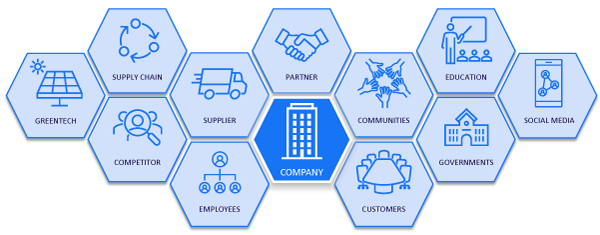SUSTAINABILITY EXECUTIVE UPDATE VOL. 1, NO. 5

Operationalizing Sustainability
Many organizations are currently struggling to embed sustainability within their operations and governance. This holds back their progress toward their stated goals and prevents them from unlocking the benefits that sustainability brings. At the same time, there has been a growth in new, sustainability-native organizations. Akin to digital natives, these organizations have been created with sustainability at their core and are providing potential competition (and ecosystem partners) for more traditional businesses.
Overall, to deliver progress in operationalizing sustainability, companies need to focus in four key areas:
-
Adopt an ecosystem approach.
-
Integrate sustainability indicators, reporting, and tools.
-
Redefine culture and build new capabilities.
-
Focus on innovation and technology.
1. Adopt an Ecosystem Approach
Currently, many organizations are turning to their traditional, linear supply chain partners to increase sustainability. This does deliver some benefits but given the scale of the challenge, they need to adopt more circular approaches and involve nontraditional partners.
These partners could include nongovernmental organizations, peers, local and national public administrations, employer organizations, and startups.
Next, it is vital to listen to those entities’ concerns, incorporate these into strategy, adopt common standards, and take action. Examples of companies that have reached beyond their traditional partners include the following:
-
Umicore. Looking outside its traditional value chain, Umicore set up new relationships with Toyota, Nokia, and Sony around the “closed loop” recycling of materials.
-
Aena. One of the largest airport operators in the world, Aena published an ambitious Climate Action Plan. Recognizing the need to influence the broader aviation ecosystem, the plan also includes measures for airlines and handling companies.
Organizations must act now to position themselves effectively within these ecosystems. First-mover advantage is vital to maximizing their share of the opportunity ahead of competitors and other ecosystem players (see Figure 1).

2. Integrate Sustainability Indicators, Reporting & Tools
Organizations should set the right science-based targets that are understandable and clear — and measure them effectively, internally and externally. Understanding progress toward sustainability goals relies on accurate, timely data that can be used to underpin every business decision. This approach must be embedded within the organization so that managers have immediate access to tools such as carbon-pricing calculators when planning operations. With science-based targets, there is a major risk of failing to meet long-term objectives if companies fail to achieve interim goals through poor planning.
The Right Tools
For many organizations, a lack of effective, automated tools is holding back collecting and sharing data and thus monitoring and improving sustainability performance. Given their importance, sustainability tools should be as strong and feature-rich as those used in operational and financial systems and should integrate with these systems as well.
Whether created in-house or sourced externally, tools should follow industry-standard frameworks and harness artificial intelligence and machine learning to remove the need for labor-intensive collection and analysis to deliver faster, more automated monitoring and reporting.
Given the complexity of many organizations, the tools must be able to monitor sustainability at both a product and portfolio level and cope easily with major business changes such as divestments and M&A.
Incentivize Based on a Balanced Set of Indicators
Oftentimes, the linkage between management incentives and sustainability performance is lacking, due to the difficulty of selecting meaningful and appropriate indicators. Sustainability targets are long-term and require cooperation within and beyond the organization, making it hard to capture meaningfully in annual renumeration packages.
Companies should therefore work toward developing and reporting on a balanced set of indicators suitable for their particular business, backed up by a strong governance system to track progress. These should take into account key principles, such as:
-
Reflecting both short-term and long-term goals in incentives
-
Ensuring that these goals accurately reflect corporate strategy
-
Taking a broader stakeholder view, measuring beyond company activities to include the wider supply chain
-
Considering multiple sustainability dimensions; for example, not just climate change but also waste, energy, and diversity and inclusion
-
Balancing lagging impact measures (e.g., emissions) with leading proactive measures (e.g., controls implemented)
Develop Investor-Oriented Reporting
Simply creating a sustainability report because it is considered mandatory due to the current business climate is counter-productive. Such a report will lack strategic direction and objectives and will not contain robust data. This means it can hinder the potential for unlocking sustainable investor value.
Instead, companies should rethink their reporting from a mere end-of-year assessment toward an ongoing, regular (e.g., quarterly) commitment toward shareholders and investors, similar to their approach to financial reporting. Such a strategy puts organizations in a better position to leverage green/sustainable financing, increase the accuracy of analysts’ earnings forecasts, and reduce negative environmental, social, and governance (ESG) incidents, such as accusations of greenwashing (claiming better sustainability performance than is happening in reality).
3. Redefine Culture & Build New Capabilities
Integrating sustainability into existing operations is a transformative exercise. Organizations need to successfully undergo cultural change to ensure all employees understand its importance and what it means to their roles. Implementing new systems and processes will be successful only if the people involved use them.
As with any culture change program, embedding sustainability requires:
-
Regular, in-depth, clear communication. Sustainability is a journey, so take everyone with you by showing the benefits. Inspire your people to want to become involved.
-
Defining and adopting a common language around sustainability. This language must extend not just within the organization but across the wider value chain and convey what sustainability means to the business on a day-to-day basis.
-
Strong leadership and clear incentives. From the top down, ensure behavior reflects the fact that sustainability is an integral part of the success of the business, not just a regulatory necessity.
-
Increase “pull” from employees. The entire organization should seek shared beliefs, values, and aligned incentives, rather than just relying on “push” techniques such as imposing new rules and processes.
-
Ensure you have the right capabilities in place. In addition to tools and technology, look to develop the skills you need internally, whether through retraining, recruitment, or ecosystem partnerships. Provide adequate resources and put in place strong governance and a detailed roadmap against which to measure and monitor your progress.
4. Focus on Innovation & Technology
New and improved technology is central to successful sustainability initiatives. On the positive side, innovation is accelerating progress in areas as diverse as solar, electric vehicle/batteries, waste recycling, air/water treatment, and green hydrogen. As such technologies mature, their costs are decreasing, enabling large-scale deployments and making sustainability more accessible. For example, the cost of solar photovoltaic energy dropped by 82% between 2010 and 2019, while efficiency saw a fivefold increase.
Organizations should look to bring sustainability and innovation together. Four ways to achieve this are:
-
Leverage innovation to increase sustainability. Use innovation to become more sustainable, from product service ideation to organizational improvements. Factoring sustainability into decisions about which projects to pursue not only enables organizations to meet current requirements but also creates future opportunities. For example, Ericsson is now taking development of its range of System on a Chip products (integrated circuits that bring together all or most components required to operate in a single chip) in-house. Through close codesign of hardware and software, it is now able to create high-performing, energy-efficient products for a wide range of deployment options, as well as providing Ericsson greater control over its 5G portfolio development.
-
Seek out the right technologies across your ecosystem. Sustainability breaks down barriers between traditional value chains, so do not limit your technology choices. Explore wider ecosystems and engage with diverse, new partners (e.g., research institutions and universities) to find the right innovations to improve sustainability performance. Revisit your own innovation pipeline — are there technologies you can develop, acquire, or harness to deliver sustainability?
-
Encourage adoption of sustainable technologies. Adopting new sustainability technologies is vital but needs to be managed carefully to avoid impacting current performance when deploying immature solutions. Create clear mechanisms and processes that enable the testing and adoption of sustainable innovations and technologies within the core business, such as through large-scale pilots.
-
Harness a portfolio sustainability analysis approach. Portfolio sustainability analysis (PSA) helps focus innovation pipelines on relevant technologies. PSA acts as a radar to capture weak sustainability signals and move them to R&D, maximizing resources and increasing the flow of sustainable innovations.
Develop & Adopt New Business Models
Sustainability delivers new opportunities for growth, particularly within the circular economy. For example, new revenue streams can be built around waste processing, recycling end-of-life products and reusing or selling their constituent parts. Working with partners, sustainable materials can be created (such as from biomass) and used to underpin new business models, such as bio-based clothing.
Introducing “as a service” business models provides additional revenue opportunities by enabling companies to connect more closely to customers to meet their ongoing needs. This also gives a greater incentive to create longer-lasting, more durable products as the company is responsible for maintenance and ensuring uptime. For example, automotive manufacturers are not only rapidly transitioning to electric vehicles, reengineering their traditional business models and supply chains to support this change, but are also introducing new mobility-as-a-service offerings. Service-based models are typically winner-takes-all, so companies should explore opportunities early to identify the right targets. First-mover advantage can be crucial to success.
The Need & Benefits of Acting Now
Despite concrete targets for sustainability, ADL’s research shows that progress on embedding it has been slow. This is largely due to the enormous, practical challenges of putting sustainability at the heart of operations and business models. Organizations are struggling to measure sustainability performance, communicate strategy internally, change culture, and engage with their wider ecosystem, all while dealing with the complexities of running and growing their business.
The positive news is that the wider picture is changing. Technology advances are enabling sustainability, new tools and frameworks are being proven in the field, consumer demand is growing, and best practice is emerging and being shared across ecosystems. Plus, institutional and government players are offering greater volumes of green funding.
Therefore, now is the time to act and operationalize sustainability. Not only will this deliver benefits in combating climate change and improving the world around us, but it simply makes good business sense. Effective sustainability strategies improve efficiency and financial performance, lower the cost of capital, better engage internal and external stakeholders, and provide new opportunities for growth. Overcoming the challenges to embedding sustainability is therefore a business imperative for all.






